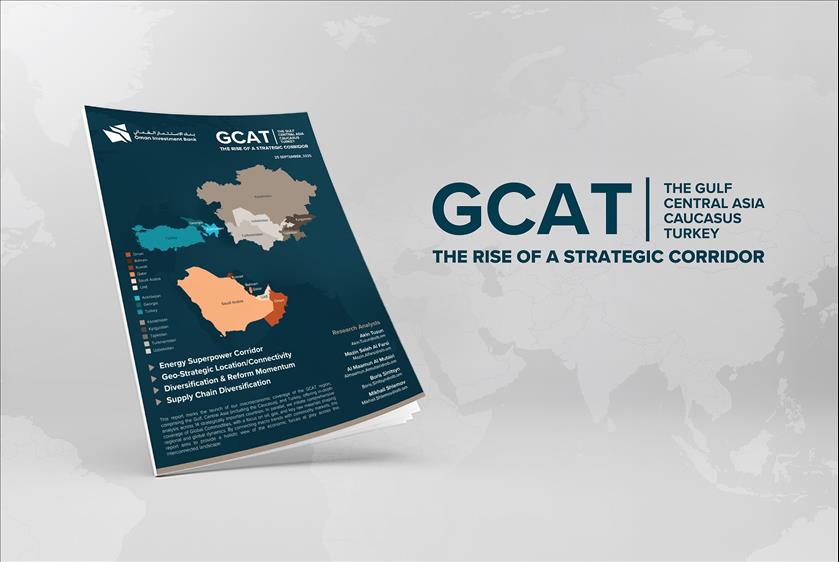
403
Sorry!!
Error! We're sorry, but the page you were looking for doesn't exist.
Oman Investment Bank releases the GCAT report, a comprehensive study of economic trends across the Gulf, Central Asia, and Turkey
(MENAFN- Prime Advertising LLC) Oman Investment Bank announced the release of its new report titled “GCAT: The Rise of a Strategic Economic Corridor,” which highlights economic performance and developments across the Gulf, Central Asia, the Caucasus, and Turkey, offering in-depth analysis of macroeconomic trends, growth indicators, and regional integration within these emerging markets.
The report covers 14 strategically significant economies and underscores the region’s growing importance as an integrated economic hub connecting energy-rich Gulf states with resource-abundant Central Asian countries, extending to European markets through Turkey, Azerbaijan, and Georgia. Together, these economies represent a combined GDP of approximately USD 4.4 trillion, equivalent to 4% of global GDP, with an average annual growth forecast of 4.4% between 2025 and 2027, surpassing the 3.9% average growth rate of other emerging markets.
Commenting on the launch, Akin Tuzun, Head of Research at Oman Investment Bank, said: “The GCAT Report reflects our broader research vision to connect macroeconomic analysis with commodity market dynamics across the Gulf, Central Asia, the Caucasus, and Turkey. This region is becoming an increasingly pivotal corridor for global trade, energy, and investment flows. By combining precise country-level forecasts with sectoral and commodities analysis, we aim to enable investors and policymakers to better understand how diversification, energy transformation, and trade integration are shaping long-term growth trajectories across this expanding economic corridor.”
Building on these insights, the report emphasizes that energy continues to serve as a cornerstone of regional integration and growth, as the Gulf, Central Asia, the Caucasus, and Turkey collectively hold 35% of the world’s crude oil reserves and 30% of natural gas reserves, while accelerating investments in renewable energy and green projects.
The report reaffirms Oman Investment Bank’s commitment to delivering data-driven, in-depth economic insights that enhance the understanding of regional and global trends in trade, growth, and investment. It further highlights the Bank’s position as a trusted source of specialized analysis and a key contributor to national efforts aimed at positioning the Sultanate as a leading financial and investment hub in the region, while shedding light on ongoing economic diversification in the Gulf, sustained growth momentum across Central Asia, and Turkey’s growing role as a regional bridge connecting East and West.
The report covers 14 strategically significant economies and underscores the region’s growing importance as an integrated economic hub connecting energy-rich Gulf states with resource-abundant Central Asian countries, extending to European markets through Turkey, Azerbaijan, and Georgia. Together, these economies represent a combined GDP of approximately USD 4.4 trillion, equivalent to 4% of global GDP, with an average annual growth forecast of 4.4% between 2025 and 2027, surpassing the 3.9% average growth rate of other emerging markets.
Commenting on the launch, Akin Tuzun, Head of Research at Oman Investment Bank, said: “The GCAT Report reflects our broader research vision to connect macroeconomic analysis with commodity market dynamics across the Gulf, Central Asia, the Caucasus, and Turkey. This region is becoming an increasingly pivotal corridor for global trade, energy, and investment flows. By combining precise country-level forecasts with sectoral and commodities analysis, we aim to enable investors and policymakers to better understand how diversification, energy transformation, and trade integration are shaping long-term growth trajectories across this expanding economic corridor.”
Building on these insights, the report emphasizes that energy continues to serve as a cornerstone of regional integration and growth, as the Gulf, Central Asia, the Caucasus, and Turkey collectively hold 35% of the world’s crude oil reserves and 30% of natural gas reserves, while accelerating investments in renewable energy and green projects.
The report reaffirms Oman Investment Bank’s commitment to delivering data-driven, in-depth economic insights that enhance the understanding of regional and global trends in trade, growth, and investment. It further highlights the Bank’s position as a trusted source of specialized analysis and a key contributor to national efforts aimed at positioning the Sultanate as a leading financial and investment hub in the region, while shedding light on ongoing economic diversification in the Gulf, sustained growth momentum across Central Asia, and Turkey’s growing role as a regional bridge connecting East and West.

Legal Disclaimer:
MENAFN provides the
information “as is” without warranty of any kind. We do not accept
any responsibility or liability for the accuracy, content, images,
videos, licenses, completeness, legality, or reliability of the information
contained in this article. If you have any complaints or copyright
issues related to this article, kindly contact the provider above.
Most popular stories
Market Research

- Pepeto Highlights $6.8M Presale Amid Ethereum's Price Moves And Opportunities
- Codego Launches Whitelabel Devices Bringing Tokens Into Daily Life
- Zeni.Ai Launches First AI-Powered Rewards Business Debit Card
- LYS Labs Moves Beyond Data And Aims To Become The Operating System For Automated Global Finance
- Whale.Io Launches Battlepass Season 3, Featuring $77,000 In Crypto Casino Rewards
- Ceffu Secures Full VASP Operating License From Dubai's VARA



















Comments
No comment